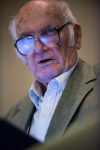 Lev P. Vinnik serves as the head of the Group of Seismological Studies in the Russian Academy of Sciences’ Institute of Physics of the Earth, based in Moscow. A pioneer in body-wave seismology for more than 50 years, Vinnik is well-known for his careful and meticulous data analyses and for developing some of the fundamental tools that seismologists around the globe use to study the interior of the Earth.
Lev P. Vinnik serves as the head of the Group of Seismological Studies in the Russian Academy of Sciences’ Institute of Physics of the Earth, based in Moscow. A pioneer in body-wave seismology for more than 50 years, Vinnik is well-known for his careful and meticulous data analyses and for developing some of the fundamental tools that seismologists around the globe use to study the interior of the Earth.
In his nomination for the Medal, his colleagues noted that his innovative research and superb observational skills came at a time when Vinnik possessed fewer technical and financial resources than many of his colleagues working outside of the former Soviet Union and later the Russian Federation. His dedication and passion for science has led his colleagues to invite him to participate in collaborations in Western Europe, Japan and the United States.
“Although he uses digitally recorded seismograms to work at the forefront of seismology today, his early work relied on analog recordings, which he had to digitize. Only those who have engaged in such tedious work can fully appreciate the tenacity and foresight it took for him to achieve this success,” said Peter Molnar, a professor of geological sciences at the University of Colorado, Boulder.
“This is unexpected and exciting news. I am greatly indebted to my foreign colleagues for this honor and for their support during my career,” said Vinnik.
Some of Vinnik’s exceptional contributions to seismology have come from his observations of unusual waveform features that he was able to interpret as measures of significant structural characteristics in the Earth’s mantle and core. His observations of P and S converted waves led to his pioneering application of receiver functions to study the upper mantle, and his discovery of splitting among SKS waves helped to confirm and quantify changes in seismic anisotropy in the mantle. These observations, along with numerous others, helped to develop the science of seismic tomography.
Along with a substantial body of published work, Vinnik participated in developing the techniques for detection of nuclear explosions and analysis of recordings of nuclear explosions in the program of Deep Seismic Sounding in the Soviet Union. Among other findings, he discovered that seismic noise in central Asia consists mainly of P waves with steep incidence angles. Previously the noise has been attributed to surface waves.
Vinnik graduated from the Geological Faculty, Department of Geophysics at Moscow State University in 1957. He received his Candidate degree (Ph.D. equivalent) in 1966 and a Doctor of Science degree in physics and mathematics in 1976.
